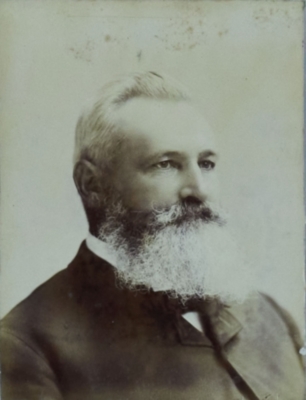Ernest Whitfeld
Individual, P010
Biography
Ernest Whitfeld (1844-1923) was born at Southport, Van Diemen’s Land, in 1844, the son of Frederick Francis Whitfeld, who was government medical officer of the settlement at Southport. Frederick came from Kent, England, in 1842.The family moved to Richmond then to Longford where Ernest received his early education at Miss Murray’s school. He also attended Christ’s College at Bishopsbourne and Mr R. N. Habart’s school at Longford. At the age of 19 he travelled to New Zealand where he gained much farming knowledge. He returned ten years later to settle in the North East.
He came to Launceston in 1880 and took up some mining interests. He was appointed acting police magistrate and acting commissioner of the Court of Requests in 1886; and in 1894 became police magistrate and commissioner of the Court of Requests at Launceston and Lilydale. By 1903 he had retired from both these positions.
On 29th March 1884 he married Lavinia Dunning of Launceston. They had two children.
He was extremely interested in the tourist industry and was a very active chairman of the Tourist Association, being well aware of what the island had to offer to visitors. Likewise, he was very effective as chairman of the City and Suburban Improvement Association. He was made a life member of the Mechanics’ Institute in recognition of his work on its behalf as president and in other offices. He gave several lectures on the history of Launceston and its people, collaborating with a George Fuller who had lived in Launceston during the 1830s and 40s.
Ernest Whitfeld was made a member of the Licensing Board and a special judge at the International Exhibition in Launceston in 1892. He was elected to the chair of the Public Works Commission in 1904, and when the Royal Commission on Education was appointed in 1907, he was made a member.
He took an interest in every aspect of Launceston’s growth, in its culture and its youth. He was involved with the Literary and Musical Competitions and was a trustee of the Launceston Church Grammar School.
For many years he was a lay-reader of St. John’s Church, treasurer and churchwarden there and was a member of the Building Fund Committee formed in the 1890s for the. 1901-1911 extensions at the church. He gave a great deal of his life to charitable works. Another great interest was history. He wrote extensively on the State’s church history, including articles on the pioneer clergymen of Tasmania and contributed considerably to the 1900 edition of the “Cyclopaedia of Tasmania”.
He died on 26th April 1923. At St. John’s Church a marble plaque was erected in the chapel in his memory and also the St. John Street iron gates on the property boundary were given. The plaque is inscribed as follows:
TO THE MEMORY OF
ERNEST WHITFELD
WHO DIED 26 APRIL 1923
HONOURED FOR HIS SERVICES
AND PARTICULARLY IN CONNECTION WITH THE ERECTION OF THIS CHURCH BUILDING
WARDEN, LAY-READER, HISTORIAN
And on the iron gates:
IN MEMORY OF ERNEST WHITFELD ESQ.
Source
Extract from 'Engraved in Memory' by J.S.Gill. 1988Related objects
Church Messenger 1896-1902 (contributor)Parish Messenger 1892-1894 (creator)
The Churchman 1905-1910 (creator)
Parish Messenger 1920 - 1985 (contributor)
Memorial Plaque - Ernest Whitfeld (Memorial to)
gates - memorial to Ernest Whitfeld (Memorial to)
